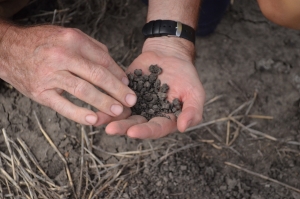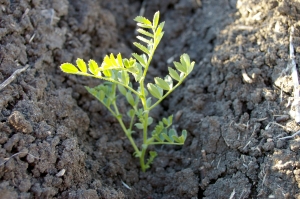
Growers are advised to consider the plant-back implications of Group A herbicides following applications in recent weeks to control an explosion of grass weeds in paddocks across the northern region.
Independent Consultants Australia Network (ICAN) weed specialist Mark Congreve urges growers and advisers to keep in mind these herbicides can have short-term soil persistence, so it is important to understand that plant-back restrictions may apply.
“There are several use patterns where a Group A herbicide may have been used over summer,” Mr Congreve said.
“Plant-back statements on most product labels have been developed to account for situations where the Group A herbicide has been applied as a post-emergent application in broadleaf crops (See Table 1 below). This allows time for herbicide dissipation before planting a following winter cereal.”
More recently, some Group A herbicides have been used in fallow situations to target problematic summer grass weeds such as feathertop Rhodes grass or barnyard grass. Only certain Group A herbicides have a registration or minor use permit that supports this practice (See Table 2 and 3 below).
Mr Congreve said it was important growers were aware there were no registrations or current permits that supported the use of any Group A herbicide via optical sprayers and plant-back periods via this use pattern are unknown.
How do these herbicides degrade in the soil?
Soil microbes are primarily responsible for degradation of the active herbicide.
“The highest microbial populations, and therefore fastest degradation, will occur when the soil is warm, the 0-10cm zone is moist and there is adequate organic matter,” Mr Congreve said.
“Under these conditions, herbicide breakdown can be rapid.

“But the shorter the period between application and sowing a cereal crop the greater the chance of herbicide residues still being in the soil.”
Mr Congreve said using high application rates would also increase the possibility of residues persisting.
“The worst-case scenario is likely to occur when we start with a high application rate and then the soil surface dries out for a period of weeks and hence the herbicide is not breaking down,” he said.
“Where residues in the soil remain at planting, they are likely to be most damaging on lighter soil types or where significant rainfall is received between planting and emergence of the cereal crop.
“These scenarios will see the highest concentration of herbicide available in the soil moisture.
“If the crop is under additional stress (e.g. frost, waterlogging, deep planting) it will not be able to metabolise the herbicide adequately and crop injury is more likely to occur.”
What do the trials say?
Plant-back trials for all herbicides produce inconsistent results, with Group A herbicides being no exception. Often, trials do not show herbicide damage at all, but labelled plant-back periods need to reflect the worst-case scenario.
From 2014 to 2016 the Northern Grower Alliance (NGA) undertook a large research project to evaluate a range of Group A herbicides (Verdict®, Targa®, Shogun®, Elantra Extreme® and Status®) applied at various times prior to planting sorghum (eight trials) and winter cereals (three trials).

NGA research manager Lawrie Price said damage had been highly variable across all trials.
“Some trials showed no damage to crops from any of the herbicides, even with quite short plant-back periods. However, when you look at the data across all trials, each herbicide was implicated in damage in at least some of the trials,” Mr Price said.
“In general, the chance of getting carry-over damage with any Group A herbicide increased as the plant-back period shortened, and especially where there was rain during crop establishment.”
Mr Congreve said when it came to understanding plant-back requirements it was advisable growers started with the label instructions.
“Then they need to look at the climatic conditions from planting and evaluate the chance of getting rainfall while the crop is trying to emerge,” he said.
“Also consider the application rate. For example, the permitted application rate for haloxyfop in fallow is double what the maximum label rate is, when applied in an in-crop situation. This increased rate will increase the likelihood of carry-over.
“If you are concerned there may be soil residual carry-over of Group A herbicides, then the safest bet is to switch to a broadleaf winter crop such as chickpea, faba beans or canola.”
The GRDC publication ‘ provides additional information on herbicide breakdown and plant-back information for many herbicides.
Table 1. Key summer crop uses of Group A herbicides
Situation: | Herbicide | Maximum registered use rate | Plant-back to winter cereals |
Post-emergent grass weed control in cotton and other summer broadleaf crops (e.g. mungbeans, navy beans soybeans, peanuts, sunflowers). Most Group A herbicides have registrations for some, or all, of theses crops. Check labels for individual uses. | butroxydim (e.g. Factor®) | 180 g/ha of a 250g/kg product | 4 weeks |
clethodim (e.g. Select®) | 500 mL/ha of a 240g/L product | No advice provided on the label | |
fluazifop (e.g. Fusilade®) | 1 L/ha of a 212g/L product | 12 weeks | |
haloxyfop (e.g. Verdict®) | 150 mL/ha of a 520g/L product | 12 weeks | |
propaquizafop (Shogun®) | 900 mL/ha of a 100g/L product | 28 days | |
quizalofop (e.g. Targa®) | 1000 mL/ha of a 100g/L product | 18 weeks | |
When used in this situation (i.e. in-crop use) there will typically be adequate separation between use in the crop and sowing of the winter cereal. However, consider plant-back periods should the summer crop ‘fail’ and not be taken to harvest. | |||
Table 2. Group A herbicides registered for use in fallow
Situation: | Herbicide | Maximum registered use rate | Plant-back to winter cereals |
Feathertop Rhodes grass control in fallow and prior to sowing summer or winter crops | propaquizafop (Shogun®) | 500 mL/ha of a 100g/L product | 28 days |
Table 3. Group A herbicides permitted for use in fallow
Situation: | Herbicide | Maximum registered use rate | Plant-back to winter cereals |
APVMA PERMIT PER12941 Feathertop Rhodes grass control in fallow and prior to planting mung beans (Qld only) | haloxyfop (e.g. Verdict®) | 300 mL/ha of a 520g/L product | No advice provided on the permit |
When used in this situation (i.e. used in fallow prior to planting mung beans) there is expected to be adequate time for herbicide dissipation prior to sowing winter cereals. Note that there is a 12-week plant-back period to winter cereals when used in summer crops at a maximum use rate of 150 mL/ha. | |||
APVMA PERMIT PER13460 Windmill grass control in summer fallow (NSW only) | quizalofop (e.g. Targa®) | 1000 mL/ha of a 100g/L product | No advice provided on the permit |
Note that there is a 18-week plant-back period to winter cereals when used in summer crops at equivalent use rates. | |||








